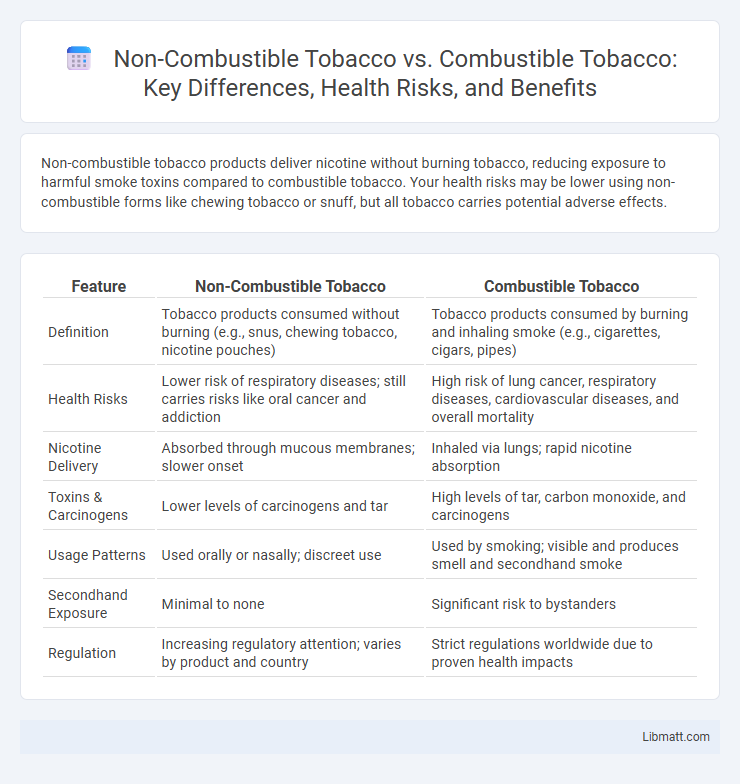Non-combustible tobacco products deliver nicotine without burning tobacco, reducing exposure to harmful smoke toxins compared to combustible tobacco. Your health risks may be lower using non-combustible forms like chewing tobacco or snuff, but all tobacco carries potential adverse effects.
Table of Comparison
| Feature | Non-Combustible Tobacco | Combustible Tobacco |
|---|---|---|
| Definition | Tobacco products consumed without burning (e.g., snus, chewing tobacco, nicotine pouches) | Tobacco products consumed by burning and inhaling smoke (e.g., cigarettes, cigars, pipes) |
| Health Risks | Lower risk of respiratory diseases; still carries risks like oral cancer and addiction | High risk of lung cancer, respiratory diseases, cardiovascular diseases, and overall mortality |
| Nicotine Delivery | Absorbed through mucous membranes; slower onset | Inhaled via lungs; rapid nicotine absorption |
| Toxins & Carcinogens | Lower levels of carcinogens and tar | High levels of tar, carbon monoxide, and carcinogens |
| Usage Patterns | Used orally or nasally; discreet use | Used by smoking; visible and produces smell and secondhand smoke |
| Secondhand Exposure | Minimal to none | Significant risk to bystanders |
| Regulation | Increasing regulatory attention; varies by product and country | Strict regulations worldwide due to proven health impacts |
Introduction to Tobacco Products: Combustible vs Non-Combustible
Non-combustible tobacco products, such as nicotine pouches and heated tobacco devices, do not involve burning tobacco, reducing the release of harmful smoke and toxicants compared to traditional combustible cigarettes. Combustible tobacco, including cigarettes and cigars, produces smoke through combustion, which contains numerous carcinogens and harmful chemicals associated with serious health risks. Understanding the differences between these products can help you make informed decisions about tobacco use and its impact on your health.
Defining Combustible and Non-Combustible Tobacco
Combustible tobacco refers to products like cigarettes and cigars that release nicotine through burning tobacco leaves, generating smoke containing harmful chemicals. Non-combustible tobacco includes alternatives such as chewing tobacco, snuff, and heated tobacco products, which deliver nicotine without burning, reducing exposure to toxic combustion by-products. Understanding these definitions is critical for evaluating health risks and regulatory approaches associated with each tobacco category.
Common Types of Combustible Tobacco Products
Common types of combustible tobacco products include cigarettes, cigars, and pipe tobacco, all of which rely on burning tobacco leaves to generate smoke inhaled by the user. These products typically contain additives and produce harmful chemicals through combustion, significantly increasing health risks like lung cancer and heart disease. Non-combustible tobacco options, such as snus and nicotine pouches, offer alternatives without smoke, reducing exposure to harmful toxins associated with traditional combustible tobacco.
Overview of Non-Combustible Tobacco Alternatives
Non-combustible tobacco alternatives, including products like smokeless tobacco, snus, and nicotine pouches, offer a smoke-free way to consume nicotine without the harmful byproducts of combustion. These products significantly reduce exposure to tar and toxic chemicals compared to traditional combustible cigarettes, potentially lowering health risks associated with smoking. Your choice of non-combustible tobacco can influence harm reduction strategies and support smoking cessation efforts by providing nicotine delivery without inhaling smoke.
Health Risks: Combustible Tobacco Compared to Non-Combustible
Combustible tobacco products, such as cigarettes, release thousands of toxic chemicals and carcinogens due to the burning process, significantly increasing the risk of lung cancer, heart disease, and respiratory illnesses. Non-combustible tobacco products, including smokeless tobacco and heated tobacco devices, generally expose users to fewer harmful chemicals, reducing but not eliminating health risks like oral cancers and nicotine addiction. Understanding these differences can help you make informed decisions regarding your tobacco use and associated health risks.
Chemical Exposure: Burning vs Non-Burning Tobacco
Non-combustible tobacco products significantly reduce exposure to harmful chemicals by eliminating the burning process responsible for releasing toxic substances found in combustible tobacco smoke. Combustible tobacco generates thousands of harmful chemicals, including tar, carbon monoxide, and carcinogens, which are linked to respiratory and cardiovascular diseases. Non-burning alternatives, such as smokeless tobacco or heated tobacco products, deliver nicotine with fewer toxicants, potentially lowering health risks associated with chemical exposure.
Smoking Cessation: Can Non-Combustible Products Help?
Non-combustible tobacco products, such as nicotine patches, gum, and heated tobacco devices, offer a less harmful alternative to traditional combustible cigarettes by eliminating the harmful effects of smoke inhalation. Research indicates that these products can support smoking cessation by reducing cravings and withdrawal symptoms, increasing the likelihood of successfully quitting smoking. You can enhance your quit plan by incorporating non-combustible options that lower health risks compared to combustible tobacco use.
Regulatory Perspectives on Tobacco Product Types
Regulatory frameworks distinguish non-combustible tobacco products, such as e-cigarettes and smokeless tobacco, from combustible products like cigarettes and cigars due to their differing health risk profiles. Many health agencies implement stricter marketing and sales restrictions on combustible tobacco due to its higher carcinogenic potential and contribution to respiratory diseases. Emerging regulations increasingly focus on setting product standards, age restrictions, and warning requirements specific to non-combustible products to address evolving public health concerns.
Consumer Trends: Shifts Toward Non-Combustible Tobacco
Consumer trends show a significant shift toward non-combustible tobacco products such as e-cigarettes, heated tobacco devices, and nicotine pouches due to growing health concerns and regulatory pressures associated with combustible tobacco. These alternatives offer reduced exposure to harmful chemicals compared to traditional cigarettes, attracting smokers seeking less harmful options without sacrificing nicotine satisfaction. Your choices are increasingly influenced by innovation and awareness, driving demand for less harmful tobacco consumption methods worldwide.
Future Outlook: Innovations in Tobacco Harm Reduction
Non-combustible tobacco products are driving the future of tobacco harm reduction through innovative technologies such as heat-not-burn devices and nicotine salts that deliver nicotine with reduced exposure to harmful chemicals compared to traditional combustible cigarettes. Market forecasts predict significant growth in the non-combustible sector, supported by regulatory shifts favoring reduced-risk products and increased consumer awareness about health risks. Advances in product formulation and delivery systems aim to maximize user satisfaction while minimizing health impacts, positioning non-combustible tobacco as a pivotal element in global tobacco harm reduction strategies.
non-combustible tobacco vs combustible Infographic

 libmatt.com
libmatt.com